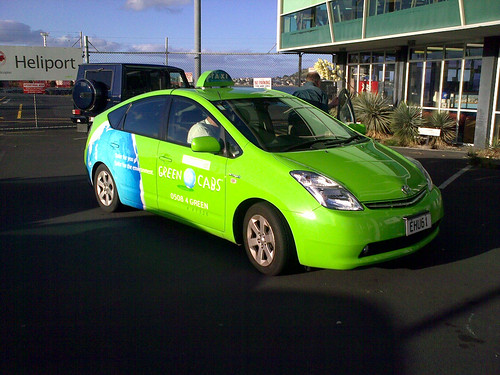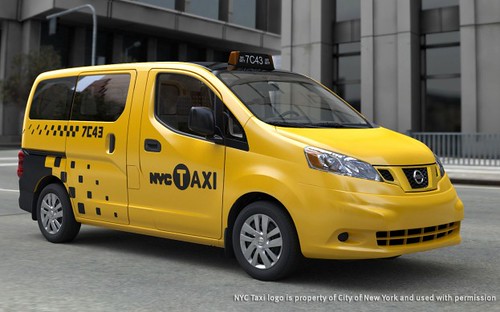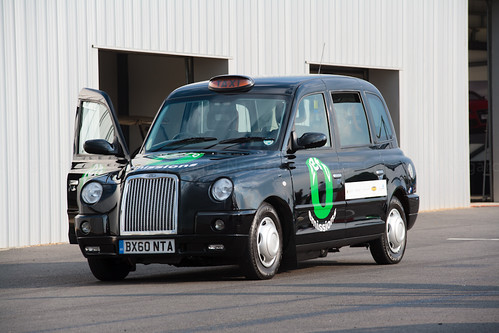The greening of America's taxis

Posted December 7, 2012 at 1:27PM
Slowly but surely, our country’s taxicab fleets are shifting to cleaner, greener vehicles. This is great news, especially given that cars are the main source of air pollution in most American cities, as well as a big chunk of our greenhouse gas emissions. While cars have gradually been getting cleaner and more fuel-efficient over the years, it hasn’t been fast enough to move many cities into compliance with health-based clear air standards.
In addition, look for taxis - like car-sharing systems - to play an increasingly important role in our transportation mix as more and more Americans forego car ownership in favor of more walkable lifestyles. Most everyone still needs a ride on occasion, especially given the limitations of public transit availability in US cities.
Arlington, Virginia, for example, is about to get a fleet of all-electric taxis. Although the county government has not approved the proposal yet as of this writing, the local government’s consent is likely to come in at least one form or another. Patricia Sullivan writes in The Washington Post that EV Taxicab, a local company, plans to launch a fleet of 40 Nissan Leaf sedans; these are electric vehicles that would be recharged at drivers’ homes and at “at least a half-dozen additional charging stations [that] would be made available for public use near the county’s busy Metrorail stations.” Each vehicle has a range of about 100 miles between charges, according to sources quoted in Sullivan’s article.
While there are questions about the effect of adding new taxi licenses on existing companies and drivers, and how the vehicles will be financed, most everyone agrees that electric and hybrid vehicles are the future of the industry. Arlington’s progressive planning and transit-oriented development has been highly successful in reducing driving rates, making the availability of taxis for spot duty especially important to county residents, an increasing number of whom do not own cars. I’ll be very surprised if this doesn’t happen soon.
Chicago launched its green taxi program in 2011, in pursuit of the goals in the city's Climate Action Plan. The program used federal stimulus funding to reimburse part of the cost of qualifying vehicles, including hybrids and those powered with compressed natural gas. 120 new taxis were put on the road as a result of the program.
My NRDC colleague Mark Izeman has reported on the greening of taxis in New York and London. Forty percent of New York’s yellow taxis -- 5,000 vehicles -- are already hybrids, though these will gradually be replaced, as will all the city’s cabs, by Nissan NV200 models, which are conventionally fueled but relatively efficient. This is part of New York’s “Taxi of Tomorrow” program.
While the NV200s will be significantly more efficient than most of New York’s current fleet, a problem with the program, at least initially, is that they could be less efficient than hybrids. Mark questions whether the city should be doing more:
“On the positive side, the initial version of this conventional, non-hybrid vehicle gets roughly double the gas mileage (25 mpg) of the long-used Ford Crown Victoria. The new taxi model also incorporates enhanced comfort and safety features. Further, Nissan – which has voiced a strong commitment to electric cars -- has indicated it could produce an all-electric version of the NV200 by 2017 and will also soon launch a pilot program to test six all-electric Nissan LEAFs cabs in the city.
“But as things now stand [July 2012], it is not clear that the final agreement between New York City and Nissan to implement the Taxi of Tomorrow program will offer a path forward to strong hybrid or electric-only taxis throughout the fleet.”
Another city with an iconic fleet of taxicabs has been moving toward a greener fleet at least since 2004 when, Mark writes, a hybrid diesel electric vehicle was first unveiled on the streets of London. During this summer’s Olympic Games, the city introduced five zero-emission hydrogen fuel cell cabs as a demonstration project. When they were about to be launched, Mark described them:
“These redesigned classic black London cabs will be powered by a combination of a hydrogen fuel cell system and a lithium battery pack, and will only emit water from their tailpipes. They reportedly can travel a full day of operation (up to 250 miles) without going through the five-minute process of refueling.”
Very impressive. Cabs in many cities, both in the US and abroad, are moving one way or another toward a greener future, and that’s a very good thing. I'd love to hear from readers about more examples.
I sometimes allow myself the luxury of a taxi ride home after a long day in the office. Here in Washington, many of the drivers are African, leading to some fascinating conversations about politics, music and food. After we talked African music for a bit, one driver sensed my enthusiasm and took me by a special shop so I could pick up some new music on my way home. Another, while talking about his favorite restaurant in a suburban strip mall, recounted the merits of some special goat-derived delicacy. “Your wife will really like it,” he stressed excitedly, “if you understand what I’m telling you, sir.” Haven’t tried it yet.
Here’s a video about the Chicago program:
Related posts:
- London's showcase of sustainable living (July 24, 2012)
- Stay thirsty, my friends: Whisky power is displacing fossil fuels (March 6, 2012)
- How to start transforming sprawl with shared personal vehicles (February 3, 2012)
- Cleaning the air with smart growth (September 16, 2010)
- Redrawing the American City: sprawl and smart growth in Chicago (January 6, 2010)
- How efficient is your mode of transportation, really? (February 12, 2009)
- America's most fuel-efficient neighborhoods, according to Forbes (July 9, 2008)
Move your cursor over the images for credit information.
Please also visit NRDC’s sustainable communities video channels.


